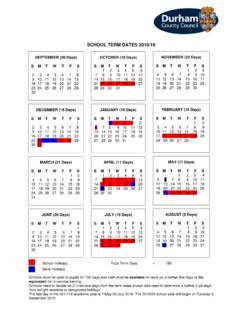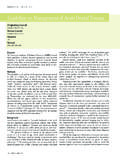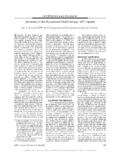Transcription of TEESDALE Saved Policies
1 1 Foreword Background The 2004 planning reform introduced a new planning policy framework across the country. Furthermore Local Government reorganisation has resulted in the amalgamation of the 7 former Durham District and Borough Authorities with Durham County Council. As a result the new unitary council, Durham County Council as sole Local Planning Authority for County Durham, is preparing a new plan for the district known as the Local Development Framework. This new plan will transitionally replace the existing 9 adopted Local Plans. The new planning system made provision for the existing Local Plans to be Saved for an initial three year period.
2 This is to ensure that they remained a material consideration for the determination of planning applications and to safeguard against a policy vacuum. This initial three year period ended on 27th September 2007. As the former Council s of County Durham were still in the early stages of preparing the new plan for their respective areas an application was made directly to the Secretary of State for Communities and Local Government to save the Local Plan Policies still considered necessary for a further three years. Each former Council s application was successful as a result directions were served on each Council confirming all Policies to be Saved and extending their life for a further three years.
3 These Policies can therefore continue to be used in the determination of planning applications. The remaining Policies expired on 27th September 2007; they were effectively deleted on this date. To make the application to the Secretary of State for Communities and Local Government, the Councils had to follow a strict protocol. The key considerations included whether the Policies repeated or were contrary to national or regional planning policy, whether they contributed towards the overall development strategy for their areas and their contribution towards their respective Sustainable Community Plans. Any Policies which did not meet the criteria could not be Saved beyond 27th September 2007.
4 To guide interested parties through the changes resulting from the direction and subsequent amalgamation of the former Councils of County Durham, the Council has prepared this simple, easy to use guide. How to use this guide This guide, together with the Adopted Proposals Map (Adopted Proposals Maps can be viewed at ), should be used as the starting point to identify which Policies are relevant to planning proposals and applications for a given geographical area within the County. For ease the chapters and Policies identified in this document are in the same order as they appear in the relevant Local Plan.
5 Next to each policy reference and title the status of that policy is clearly set out; colours have been used to differentiate between those Policies which are Saved (Green) and those which have expired (Pink). For Saved Policies : The full policy wording is identified; Readers are directed to the relevant page number of the Local Plan where the full policy justification can be viewed; and Where appropriate, key sections of national or regional policy have been identified to be used in conjunction with the policy. For expired Policies : The appropriate action has been clearly identified. This usually directs the reader to a key piece of national or regional planning policy which has superseded the policy.
6 In addition to the above the following should be considered: Given the age of the Local Plans all Saved Policies should be read in the context of national and regional planning Policies , many of which post date the Local Plans. For a number of the Saved Policies key sections of national and regional policy have been identified for the reader; it is important to note however that these references are intended as a starting point, additional national and regional policy may also be relevant; and It is also important to consider that new evidence (such as local housing need or play and recreation standards) has emerged since the Local Plan was adopted, considerable weight during the determination of planning applications.
7 2 TEESDALE Local Plan (2002) Chapter Section Pages 1 General Development Criteria 3-4 2 The Natural Environment 5-8 3 The Built Environment 9-12 4 Population and Housing 13-18 5 Employment and the Local Economy 19-20 6 Shopping and Commerce 21-25 7 Tourism and Recreation 26-28 8 Transport 29-30 9 Community Services and Infrastructure 31-34 3 TEESDALE General Development Criteria Ref Local Plan Policy Status General Development Criteria Saved GD1 POLICY: Development will be permitted provided that it complies, where relevant to the proposal, with each of the following criteria:- A) It is of a high standard of design and would contribute to the quality and environment of the surrounding area, and B) It is in keeping with the character and appearance of the area in that: a.
8 It is designed to be appropriate in terms of form, mass, scale, layout, density and materials b. it has regard and is appropriate to the setting of neighbouring buildings, landscape features and open spaces of the surrounding area c. landscape, natural and historic features on the site are retained and incorporated into the design and layout of the scheme; and d. it would not result in the loss of important open spaces within the built up areas and villages of the District C) Adequate access, toilet and parking facilities are provided for the elderly, disabled and people with children for all proposals which provide access for the general public; and D) It would not disturb or conflict with adjoining uses; and E) It would not unreasonable harm the amenity of occupants of adjoining sites, and F) adequate foul and storm water drainage within and away from the development site are provided, and G) It is located and designed where possible to conserve energy and be energy efficient.
9 This should include southerly orientation of buildings, limiting the size of windows on north aspects, insulation and double glazing, screening from prevailing winds, avoiding exposed locations; and H) It is designed where possible to deter crime and to increase personal safety. Design will need to incorporate open, well lit layouts which reduce high risk areas where the user is unsighted due to vegetation, alcoves or corners; and I) It would not unreasonably harm the rural landscape of the area; and J) It would not endanger or damage important national and local wildlife habitats or have a detrimental impact on the ecology and geology of the District; and K) It would not have a detrimental impact on archaeological sites of national importance and will take account in its design and construction of other archaeological remains and their settings.
10 And L) Adequate landscaping is incorporated within the design and layout of the site and, where appropriate, wildlife habitats are created which should be in keeping with the natural habitats of the area; and M) For major land use proposals, (including roads, industrial development and housing sites over 25 dwellings on the edge of a settlement), structural landscaping around the periphery of the site is provided; and N) It would not be unacceptable detrimental to public health; and O) It would not significantly pollute the environment with dust, noise, emission, outfall or discharges of and kind; and P) It will not cause an unacceptable risk to the quality of ground or surface water; and Q) Adequate and safe access to the site is provided and parking provision is limited to that necessary to ensure safe and efficient operation of the site to encourage the use of other transport modes; and R) It would not generate unacceptable levels of traffic on the local road network; and S) Adequate links and access to public transport systems are incorporated within the layout of the site.









